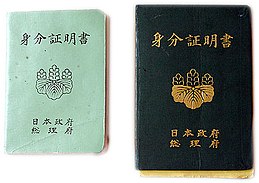Mainland Japan
Native name: 内地 | |
|---|---|
 Passports for passengers between Mainland Japan and Okinawa during 1952–1972. | |
 | |
| Geography | |
| Location | Japan |
| Demographics | |
| Ethnic groups | Japanese people Ainu people Ryukyuan people |
"Mainland Japan" (内地, naichi, lit. "inner lands") is a term used to distinguish Japan's core land area from its outlying territories. It is most commonly used to distinguish the country's four largest islands (Hokkaidō, Honshū, Kyūshū, and Shikokū) from smaller islands such as the Bonin Islands and the Ryukyu Islands. However, depending on the context, the term "Mainland Japan" may refer only to Honshū, the largest island.
The term's literal Japanese meaning might best be translated as "inner Japan" or "inner lands". The term "mainland" is somewhat inaccurate since it usually refers to all or part of a continental landmass, rather than islands.
"Mainland Japan" was an official term in the pre-war period, distinguishing Japan proper from its colonies in the Far East (which at that time included parts of mainland Asia). After the end of World War II its usage became less common and lost its previous legal significance.
Historical usage
[edit]In the Japanese Empire of the pre-war period, naichi referred to the mainland of the empire. The other territories of the empire was called gaichi (外地, lit. "outer lands").
The Meiji Constitution's Article 1 of the Common Law (共通法) enumerates the territories with legal jurisdictions namely:
Naichi
[edit]Naichi (内地, lit. "inner lands") referred to the territories under direct control of the government. They consisted of the following:[1]
- Karafuto (since 1943)
- Chishima Islands (since 1875)
- Hokkaidō
- Honshū
- Shikoku
- Kyūshū
- Izu Islands
- Ryukyu Islands (since 1879)
- Nanpō Islands (since 1891)
- Minor outlying islands around them
Gaichi
[edit]These territories were called gaichi (外地, lit. "outer lands"). They were part of the Empire of Japan, but not under direct control by the central government.
- Hokkaido (until 1947)
- Ryukyu Islands (until 1879)
- Taiwan
- Shinnan Islands (since 1938)
- Seisa Islands (since 1938)
- Karafuto (until 1943)
- Chōsen
- Kwantung Province
- South Manchuria Railway Zone
- South Seas Mandate[2]
- Kiautschou Bay Leased Territory
- Tianjin
- Hankou
- Chongqing
- Suzhou
- Hangzhou
- Shashi
Although it has never been abolished, the Common Law lost effect from enforcement after Japan lost all the former colonies, or gaichi as a result of World War II.[citation needed]
Modern usage
[edit]Residents of places like Hokkaidō, Okinawa and Amami occasionally use naichi to refer to the "mainland", excluding these areas. The colloquial usage is officially "incorrect", as both areas are legally within naichi. In Hokkaidō, the official term that refers to Japan except Hokkaidō is dōgai (lit. outside of Hokkaidō).[citation needed] With dōgai becoming common even in colloquial use, naichi ceased to be used.[citation needed] Residents of Okinawa also use the term hondo (lit. mainland) to refer to parts of Japan outside of Okinawa. In Japanese law, the meaning of hondo is used to make a distinction between the "main islands" of Hokkaidō, Honshū, Shikoku, and Kyūshū and "outlying islands" referred to as ritō.[3]
The term "main islands" (本島 hontō) is used for Hokkaido, Honshu, Kyushu, Shikoku and Okinawa. The other estimated 6,847 smaller islands are called 'remote islands' (離島 ritō).[4]
See also
[edit]References
[edit]- ^ "内地とは" [Definition of 'naichi']. コトバンク (in Japanese). 日本国語大辞典 精選版. Retrieved January 10, 2023.
一国の領土が数個に分かれている場合、憲法の定める通常の法律が行なわれる区域。旧憲法下の北海道、本州、四国、九州がこれにあたる。(The area established by the Constitution where common law applies, in cases where the territory of one country is divided into several portions. Under the old Japanese Constitution, this definition applied to the territories of Hokkaido, Honshu, Shikoku, and Kyushu).
- ^ Nakano Bunko 中野文庫. "Kyōtsūhō 共通法" (in Japanese). Archived from the original on December 23, 2014. Retrieved December 10, 2011.
- ^ "離島航路整備法". e-Gov Portal (in Japanese). Digital Agency. Retrieved July 22, 2024.
- ^ "離島とは(島の基礎知識) (what is a remote island?)". MLIT (Ministry of Land, Infrastructure, Transport and Tourism) (in Japanese). Ministry of Land, Infrastructure, Transport and Tourism. August 22, 2015. Archived from the original (website) on November 13, 2007. Retrieved August 9, 2019.
MILT classification 6,852 islands(main islands: 5 islands, remote islands: 6,847 islands)

